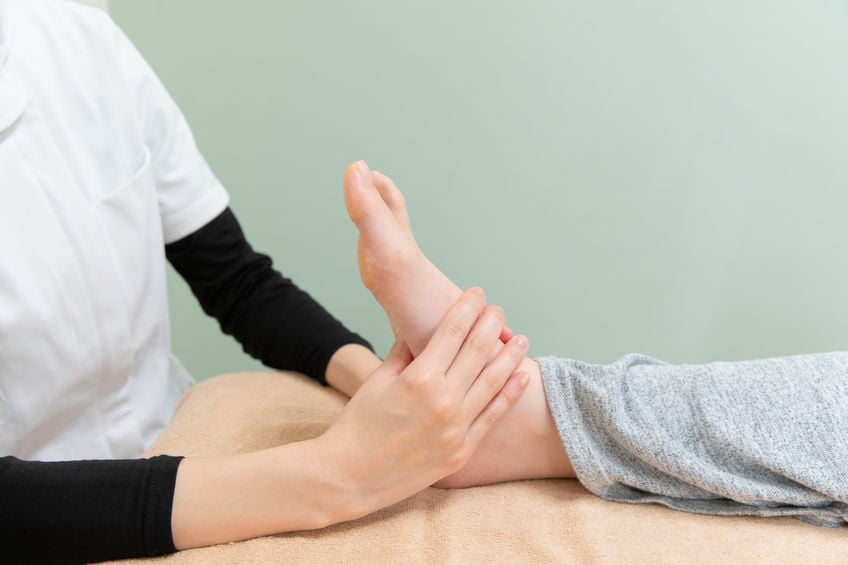Strengthen Ankles And Prevent Ankle Injuries
While some injuries can be unpredictable, many ankle injuries can be prevented. Ankle sprains and fractures are often associated with sports such as volleyball, football, running, or basketball. Strengthening and improving the range of motion of the ankle can prevent these injuries.

What are the most common ankle injuries?
The 2 primary ankle injuries that occur most often are ankle sprains and fractures. An ankle sprain is a soft tissue injury to the ligaments of the ankle. A fracture is a break in the bone.
How do stretches prevent injury?
Stretches strengthen and improve the range of motion of the ankle joint. Stretches also increase flexibility and enable muscles to work more effectively due to increased blood flow. A flexible and strong ankle has a less likely chance of injury because loose joints can react quickly. Stretches that increase flexibility and strengthen the ankle can help prevent future injuries. These 5 stretches provide the most significant benefit to the ankles.
1. Ankle circles
Sit on the ground with both legs bent in front. Cross one leg over the other and perform slow circles with the raised ankle. Be sure to circle the ankle clockwise and counterclockwise to achieve the most benefit. Repeat with the opposite ankle.
2. Heel stretch
Sit down on the floor with the knee bent slightly. Loop a towel around the top of the foot. Gently pull back until the feeling of stretching is felt in the calf and heel. Repeat on the opposite leg.
3. Calf raises
Stand with the feet around hip-width apart, shift weight onto the toes, and slowly lift the heels off the ground. Keep the ankles in a neutral position to prevent the ankles from rolling out.
4. Shin raises
This stretch is similar to calf raises. Stand with the feet around hip-width apart, shift weight onto the heels, and slowly lift the toes off the ground. Maintain proper control while lifting the toes out and down to prevent the ankles and toes from rolling in.
5. Single-leg balance
Stand on one foot, bend the standing knee slightly, and hold for 20-30 seconds. The body may start to shake, but this is a sign that the muscles in the leg are working. Control the ankle to minimize shaking. Repeat this exercise on the opposite leg.
How else can I prevent ankle sprains and fractures?
The best way to prevent ankle sprains and fractures is to maintain excellent flexibility, muscle strength, and balance. Be sure to warm up before exercising, pay careful attention when walking on uneven surfaces, and wear proper footwear. For more information about injury prevention, speak with an orthopedic specialist.
Can Lower Back Pain Return After Spinal Surgery? 3 Lifestyle Changes To Get The Most Out Of Fusion
Minnesota Valley Valley Center2024-04-02T14:49:38-05:00April 15th, 2024|
Spinal surgery is an excellent solution for lower back pain, but symptoms can return. With lifestyle changes, patients can get the most out of fusion.
A New Lease On Life: Exploring How Robotic Total Joint Replacement Can Get You Active Again
Minnesota Valley Valley Center2024-03-24T17:38:47-05:00March 29th, 2024|
Robotic total joint replacement uses a robotic arm to replace the joint. This innovative approach allows a quick return to activities.
Restoring Dexterity: How Outpatient Carpal Tunnel Surgery Can Change Your Life
Minnesota Valley Valley Center2024-03-24T17:38:37-05:00March 15th, 2024|
After months of wrist and hand pain, carpal tunnel surgery may be needed. With outpatient options, restored dexterity with less pain and discomfort is possible.
More Articles from MVSC
December 14, 2023
Ankle pain is common, but sometimes arthritis is at play. An orthopedic surgeon may recommend subtalar fusion for patients.
November 28, 2023
Is bunionectomy a solution for foot pain caused by bunions? Learn about surgical and non-surgical options before a decision.
September 26, 2023
An Achilles tendon recovery timeline can be long and grueling. With rest and physical therapy, patients can see faster results.
September 19, 2023
Big toe arthritis can cause severe discomfort if left untreated. Hallux rigidus repair can provide extensive relief for patients.










